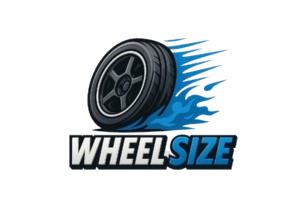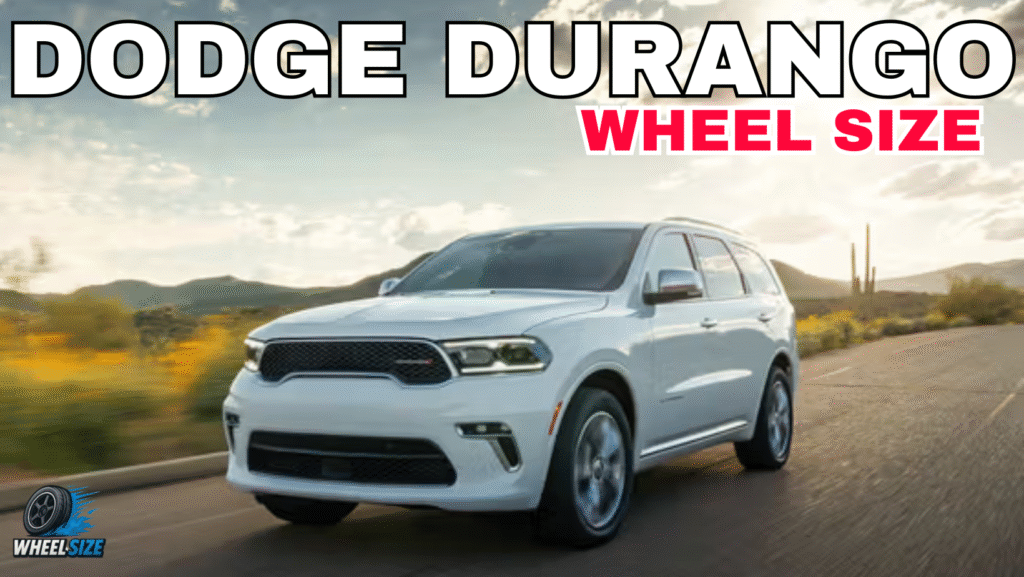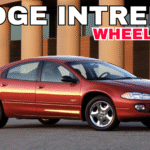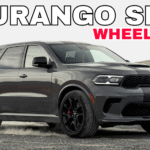The Dodge Durango is a flexible SUV that has been around for a long time. Each new generation has brought modifications to the look, performance, and, most crucially, the wheel specs. It’s important to know the bolt pattern, rim size, hub diameter, offset, and tire possibilities if you’re changing factory wheels, upgrading for performance, or just want to know what will fit. A perfect fit makes handling safer, gives you more room to brake, and makes driving more enjoyable overall. We’ll go over each iteration of the Durango in this guide, point out the differences between the SRT and Hellcat models, and provide you with useful advice on how to get the proper wheels without having any problems with fitment.
Why Correct Wheel Fitment Matters for the Dodge Durango
Getting the perfect wheel fitment is more important than just how it looks. The way your Durango drives, brakes, and rides is strongly related to its wheels. If the offset of a wheel is inaccurate, it can rub against suspension parts. If the hub bore is wrong, it can generate vibrations at highway speeds. The bolt pattern is also very important; if you use the wrong one, the wheel won’t fit securely. Even the size of your tires is important because too-big tires might mess up your speedometer and put stress on your suspension parts. Knowing the correct fitting standards will not only protect your SUV but also make it easier to handle, provide better traction, and give it a balanced stance that makes it safer and performs more effectively.
Dodge Durango Wheel Fitment by Generation
It’s crucial to know the information of the wheels before you buy new ones because each model of the Dodge Durango has its own set of wheel specs. Older versions employed bigger truck-based layouts, but newer ones have specs that are similar to those of modern SUVs. Rim sizes have also changed. In the late 1990s, they were 15 inches, but now they are 20 inches on performance trims. Hub bore sizes, offsets, and tire widths have also changed, especially since the SRT and Hellcat came out as wide-body performance models. Here is a list of the exact requirements for each generation. This way, you can be sure that the wheels you choose will fit without having to go through the trouble of trying different ones.
Dodge Durango I (DN) [1997 – 2003] Wheel Specs
The first-generation Durango was constructed on a truck basis; hence, it had tough wheel specs. This model had a 6×114.3 bolt pattern, which was popular for mid-size SUVs at the time. The rims could be anywhere from 15 to 17 inches wide, and the factory options for tires were the P235/75R15 and P265/70R16. The hub bore was about 71.5 mm, and the offsets were usually around +25 mm. This made the vehicle stable for towing and modest off-road use. These wheels were simple but strong, and they complemented the workhorse style of the early Durango. They also gave owners the flexibility to make improvements if they needed to.
| Year | Bolt Pattern (PCD) | Hub Bore | Thread Size | Torque (Nm) | OEM Tire Size | OEM Rim Size | Offset Range (mm) | Tire Pressure (bar) |
|---|---|---|---|---|---|---|---|---|
| 1997 | 6×114.3 (6×4.5) | 71.6 mm | 1/2″ – 20 UNF | 115 – 156 | 235/75R15 101S | 7JJx15 ET38.1 | 36.1 – 40.1 | 2.4 |
| 1998 | 6×114.3 (6×4.5) | 71.6 mm | 1/2″ – 20 UNF | 115 – 156 | 235/75R15 101S | 7JJx15 ET38.1 | 36.1 – 40.1 | 2.4 |
| 1999 | 6×114.3 (6×4.5) | 71.6 mm | 1/2″ – 20 UNF | 115 – 156 | 235/75R15 101S | 7JJx15 ET38.1 | 36.1 – 40.1 | 2.4 |
| 2000 | 6×114.3 (6×4.5) | 71.6 mm | 1/2″ – 20 UNF | 115 – 156 | 235/75R15 101S | 7JJx15 ET38.1 | 36.1 – 40.1 | 2.4 |
| 2001 | 6×114.3 (6×4.5) | 71.6 mm | 1/2″ – 20 UNF | 115 – 156 | 235/75R15 101S | 7JJx15 ET38.1 | 36.1 – 40.1 | 2.4 |
| 2002 | 6×114.3 (6×4.5) | 71.6 mm | 1/2″ – 20 UNF | 115 – 156 | 235/75R15 101S | 7JJx15 ET38.1 | 36.1 – 40.1 | 2.4 |
| 2003 | 6×114.3 (6×4.5) | 71.6 mm | 1/2″ – 20 | 115 – 156 | 235/75R15 101S | 7JJx15 ET38.1 | 36.1 – 40.1 | 2.4 |
Dodge Durango II (HB) [2004 – 2010] Wheel Specs
The second generation had a new look and new guidelines for how things fit. Dodge changed to a 5×139.7 bolt pattern, which is commonly called 5×5. This design is common on bigger SUVs and light trucks. The rims could now be 17 to 20 inches wide, which made the car look more expensive than the old model. The hub bore got bigger, going from 77.8 mm to 77.8 mm, and factory offsets usually ranged from +25 to +35 mm. The lug nuts were 9/16″-18, which made them stronger for heavy-duty use. Depending on the model, factory tires ranged from 245/70R17 to 265/50R20. This generation struck a good balance between comfort and functionality. The wheel design also allowed owners additional options when they wanted to upgrade to aftermarket wheels or all-terrain configurations.
| Year | Bolt Pattern (PCD) | Hub Bore | Thread Size | Torque (Nm) | Tire (OE) | Rim (OE) | Offset Range (mm) | Tire Pressure (bar) |
|---|---|---|---|---|---|---|---|---|
| 2004 | 5×139.7 (5×5.5) | 77.8 mm | 9/16″ – 18 UNF | 115 – 156 | 245/70R17 110S | 7.5JJx17 ET35 | 33 – 37 | 2.5 |
| 2005 | 5×139.7 (5×5.5) | 77.8 mm | 9/16″ – 18 UNF | 115 – 156 | 245/70R17 110S | 7.5JJx17 ET35 | 33 – 37 | 2.5 |
| 2006 | 5×139.7 (5×5.5) | 77.8 mm | 9/16″ – 18 UNF | 115 – 156 | 245/70R17 110S | 7.5JJx17 ET35 | 33 – 37 | 2.5 |
| 2007 | 5×139.7 (5×5.5) | 77.8 mm | 9/16″ – 18 UNF | 115 – 156 | 245/70R17 110S | 7.5JJx17 ET35 | 33 – 37 | 2.5 |
| 2008 | 5×139.7 (5×5.5) | 77.8 mm | 9/16″ – 18 UNF | 115 – 156 | 245/70R17 110S | 7.5JJx17 ET35 | 33 – 37 | 2.5 |
| 2009 | 5×139.7 (5×5.5) | 77.8 mm | 9/16″ – 18 UNF | 115 – 156 | 245/70R17 110S | 7.5JJx17 ET35 | 33 – 37 | 2.5 |
| 2010 | 5×139.7 (5×5.5) | 77.8 mm | 9/16″ – 18 UNF | 115 – 156 | 245/70R17 110S | 7.5JJx17 ET35 | 33 – 37 | 2.5 |
Dodge Durango III (WD) [2011 – 2020] Wheel Specs
Dodge switched to a more streamlined unibody architecture for the third-generation Durango, and the way the wheels fit changed, too. This model uses the 5×127 bolt pattern, which is commonly called 5×5 and is common on Jeep and Dodge SUVs. The hub bore was about 71.5 mm, which made it more important for smooth driving to install the hub correctly. Depending on the trim, stock rim sizes ranged from 18 to 20 inches,s and offsets ranged from +40 to +50 mm. There were two tire sizes to choose from: 265/60R18 and 265/50R20. The thread pitch on the lug nuts also changed to M14x1.50. These specs showed that the Durango was now a crossover-style SUV that balanced comfort, usefulness, and performance.
| Year | Bolt Pattern (PCD) | Hub Bore | Thread Size | Torque (Nm) | Tire (OE) | Rim (OE) | Offset Range (mm) | Tire Pressure (bar) |
|---|---|---|---|---|---|---|---|---|
| 2011 | 5×127 (5×5) | 71.6 mm | M14 x 1.5 | 176 | 265/60R18 109T | 8Jx18 ET56.4 | 54.4 – 58.4 | 2.4 |
| 2012 | 5×127 (5×5) | 71.6 mm | M14 x 1.5 | 176 | 265/60R18 109T | 8Jx18 ET56.4 | 54.4 – 58.4 | 2.4 |
| 2013 | 5×127 (5×5) | 71.6 mm | M14 x 1.5 | 176 | 265/60R18 109T | 8Jx18 ET56.4 | 54.4 – 58.4 | 2.4 |
| 2014 | 5×127 (5×5) | 71.6 mm | M14 x 1.5 | 176 | 265/60R18 109T | 8Jx18 ET56.4 | 54.4 – 58.4 | 2.4 |
| 2015 | 5×127 (5×5) | 71.6 mm | M14 x 1.5 | 176 | 265/60R18 109T | 8Jx18 ET56.4 | 54.4 – 58.4 | 2.4 |
| 2016 | 5×127 (5×5) | 71.6 mm | M14 x 1.5 | 176 | 265/60R18 109T | 8Jx18 ET56.4 | 54.4 – 58.4 | 2.4 |
| 2017 | 5×127 (5×5) | 71.6 mm | M14 x 1.5 | 176 | 265/60R18 109T | 8Jx18 ET56.4 | 54.4 – 58.4 | 2.4 |
| 2018 | 5×127 (5×5) | 71.6 mm | M14 x 1.5 | 176 | 265/60R18 109T | 8Jx18 ET56.4 | 54.4 – 58.4 | 2.4 |
| 2019 | 5×127 (5×5) | 71.6 mm | M14 x 1.5 | 176 | 265/60R18 109T | 8Jx18 ET56.4 | 54.4 – 58.4 | 2.4 |
| 2020 | 5×127 (5×5) | 71.6 mm | M14 x 1.5 | 176 | 265/60R18 109T | 8Jx18 ET56.4 | 54.4 – 58.4 | 2.4 |
Dodge Durango III Facelift (WD) [2020 – 2026] Wheel Specs
The facelifted WD Durango kept many of the outfitting details from the 2011–2020 generation, although high-end trims got performance-oriented wheels. The normal bolt pattern is 5×127, and the hub bore is about 71.6 mm. The factory standard for rims is 18 to 20 inches. The greatest change was in the performance variants, which now have 20×10 wheels to fit wider tires and bigger brakes. Offsets usually stay between +45 and +52 mm to keep the right amount of space. Standard trims come with 265/50R20 tires, while performance models come with 295/45R20 tires. Dodge worked hard to make the SUVs fit consistently while still giving it an aggressive look with this makeover.
| Year | Hub Bore (mm) | Bolt Pattern (PCD) | Thread Size | Torque (Nm) | OEM Tire Size | OEM Rim Size | Offset Range (mm) | Tire Pressure (F/R, bar) | Aftermarket Wheel Size Range |
|---|---|---|---|---|---|---|---|---|---|
| 2020 | 71.6 | 5×127 (5×5) | M14 x 1.5 | 176 | 265/60R18 109T | 8Jx18 ET56.4 | 54.4 – 58.4 | 2.4 / 2.4 | 18″–22″ |
| 2021 | 71.6 | 5×127 (5×5) | M14 x 1.5 | 176 | 265/60R18 109T | 8Jx18 ET56.4 | 54.4 – 58.4 | 2.4 / 2.4 | 18″–22″ |
| 2022 | 71.6 | 5×127 (5×5) | M14 x 1.5 | 176 | 265/60R18 109T | 8Jx18 ET56.4 | 54.4 – 58.4 | 2.4 / 2.4 | 18″–22″ |
| 2023 | 71.6 | 5×127 (5×5) | M14 x 1.5 | 176 | 265/60R18 109T | 8Jx18 ET56.4 | 54.4 – 58.4 | 2.4 / 2.4 | 18″–22″ |
| 2024 | 71.6 | 5×127 (5×5) | M14 x 1.5 | 176 | 265/60R18 109T | 8Jx18 ET56.4 | 54.4 – 58.4 | 2.4 / 2.4 | 18″–22″ |
| 2025 | 71.6 | 5×127 (5×5) | M14 x 1.5 | 176 | 265/60R18 109T | 8Jx18 ET56.4 | 54.4 – 58.4 | 2.4 / 2.4 | 18″–22″ |
| 2026 | 71.6 | 5×127 (5×5) | M14 x 1.5 | 176 | 265/60R18 109T | 8Jx18 ET56.4 | 54.4 – 58.4 | 2.4 / 2.4 | 18″–22″ |
Dodge Durango SRT & Hellcat Wheel Fitment Differences
The SRT and Hellcat are performance vehicles that have special wheel fitment criteria. Both have a 5×127 bolt pattern and a 71.5 mm hub bore, but their original wheels are different. They have 20×10 rims and 295/45R20 tires. The +50 mm offset on these wide wheels is just right for balancing clearance and the wide-body posture. One important thing to think about is brake clearance, since these models come with huge Brembo brake packages. Even if the bolt pattern matches, not all aftermarket wheels will fit. When upgrading, be sure to seek wheels that say “SRT/Hellcat brake clearance” on them to make sure they are safe and work well.
Most Popular Wheel Sizes for Dodge Durango
People who buy Durangos generally want wheels that look good and don’t change the way the car rides. A lot of people choose 20×9 wheels with +30 to +40 mm offsets on recent WD versions, along with 265/50R20 tires. Performance trims tend to be 20×10 with 295/45R20, which is near to what the factory recommends. For older HB models, 17×8.5 wheels with +18 to +25 mm offsets perform well, especially with all-terrain tires. Whether you want a street-ready stance, a performance-focused update, or a rugged off-road design, each setup gives the Durango a different look. The size of your wheels depends on how you drive, but keeping the total diameter near to stock helps keep the speedometer accurate and the handling balanced.
Aftermarket Wheel Brands That Fit Dodge Durango
When picking out aftermarket wheels, the brand’s quality is equally as important as how well they fit. Fuel Off-Road, Black Rhino, KMC, Rotiform, Method, and American Racing are all good choices for the Dodge Durango that are tough and beautiful. These manufactures make wheels with the right 5×127 or 5×139.7 designs and hub bores that fit Dodge SUVs. They also make spoke profiles that fit over big brake calipers, which is very critical for SRT and Hellcat trims. These companies offer solid fitment options for any style you want, whether it’s an aggressive off-road look, a sleek street look, or handling that focuses on performance. Before you place your order, make sure to check the offset and bore size to minimize problems with vibration or clearance.
How to Measure Wheel Fitment Correctly
It’s not hard to measure wheel fitting once you know what to look for. To begin, count the lugs and measure the distance between them. Depending on the generation, Durangos employ either 5×127 or 5×139.7. Next, measure the hub bore. This makes sure that the wheel fits snugly on the hub and doesn’t vibrate. Offset is the hardest to figure out. It tells you how far the wheel is inside or outside the fender in millimeters. A higher positive offset pulls the wheel in, whereas a lower offset pushes it out. Lastly, check the pitch of the lug threads. Older versions utilized 9/16″-18 or 1/2-20, but contemporary Durangos use M14x1.50. Double-checking these makes sure they fit perfectly.
Conclusion
The Dodge Durango has moved from a truck-based SUV to a performance-driven crossover, and the standards for the wheels have altered with each new model. The first-generation models had 6 lugs, the second-generation models had 5×139.7, and the latest WD models have 5×127 with exact offsets and bore sizes. Performance trims like the SRT and Hellcat need wide wheels that have enough space for the brakes. For a safe, smooth ride, you need to know your specific bolt pattern, offset, and bore. This is true whether you desire OEM-style comfort, an aftermarket performance increase, or tough off-road wheels. If you follow our fitment instructions, you’ll find the perfect mix of style, strength, and performance for your Dodge Durango.



